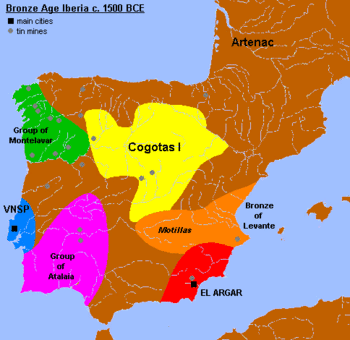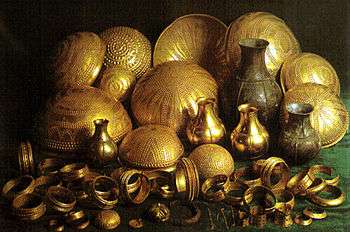El Argar

El Argar is the type site of an Early Bronze Age culture called the Argaric culture, which flourished from the town of Antas, in what is now the province of Almería in southeastern Spain, between c. 2200 BC and 1550 BC.[1] The Argaric culture was characterised by its early adoption of bronze, which briefly allowed this tribe local dominance over other, copper age peoples.[2] El Argar also developed sophisticated pottery and ceramic techniques, which they traded with other Mediterranean tribes.
The center of this civilization is displaced to the north and its extension and influence is clearly greater than that of its ancestor. Their mining and metallurgy were quite advanced, with bronze, silver and gold being mined and worked for weapons and jewelry.
Pollen analysis in a peat deposit in the Canada del Gitano basin high in the Sierra de Baza suggests that the Argaric exhausted precious natural resources, helping bring about its own ruin.[3] The deciduous oak forest that covered the region's slopes were burned off, leaving a tell-tale carbon layer, and replaced by the fire-tolerant, and fire-prone, Mediterranean scrub familiar under the names garrigue and maquis.[4][5]
Extension

The civilization of El Argar extended to all the province of Almería, north onto the central Meseta, to most of the land of (Murcia) and westwards into the provinces of Granada and Jaen.[7]
Its cultural and possibly political influence was much wider, clearly influencing eastern and southwestern Iberia (Algarve), and possibly other regions as well.
Some authors have suggested that El Argar was a unified state.[2]
Main Argaric towns
- El Argar: irregularly shaped (280 x 90 m).
- Fuente Vermeja: small fortified site, 3 km north of El Argar
- Lugarico Viejo: larger town very close to Fuente Vermeja.
- Puntarrón Chico: in the top of a small hill, near Beniaján (Murcia)
- Ifre (Murcia): on a rocky elevation.
- Zapata (Murcia): 4 km. west of Ifre, fortified.
- Cabezo Redondo (Villena, Alicante): one of the biggest settlements, on a rocky elevation next to an old lagoon and salt evaporation pond.
- Gatas (4 km west of Mojácar, Almería): fortified town on a hill with remarkable water canalizations.
- El Oficio (9 km north of Villaricos, Almería): atop of a well defended hill, strongly fortified, especially towards the sea.
- Cerro de las Viñas, Coy, Spain
- Fuente Álamo (7 km north of Cuevas de Almazora, Almería): the citadel is atop a hill, while the houses are terraced in its southern slope.
- Almizaraque (Almería): a town dating to Los Millares civilization.
- Cerro de la Virgen de Orce (Granada).
- Cerro de la Encina (Monachil, Granada).
- Cuesta del Negro (Purullena, Granada).
Periodization
The culture of El Argar has traditionally been divided in two phases, named A and B.
El Argar A
This phase started in the 18th century BC, with the earliest calibrated C-14 dates pointing to the first half or this century:
- 1785 BC (+/- 55 years) in the transitional Late Chalcolithic-Early Bronze of Cerro de la Virgen de Orce, a peripheral site.
- 1730 BC (+/- 70 years) in Fuente Álamo for El Argar A2, with six undated A1 layers under it.
- 1700 BC in Cuesta del Negro (another peripheral site) with clear Argarian materials in its lower layer.
El Argar B
This phase begins in the 16th century BC. The main C-14 date is that of 1550 BC (+/- 70 years) in Fuente Álamo for the upper layer of El Argar B2 (with four layers underneath the lowest B phase). Other stratigraphic dates are somewhat more recent but are not confirmed by C-14.
Post-Argarian phase
El Argar B ends in the 14th or 13th century BC, giving way to a less homogeneous post-Argarian culture. Again Fuente Álamo gives the best C-14 dating with 1330 BC (+/- 70 years).
Recent trends
Many more C-14 dates have been published since the beginning of the 21st century. In recent publications, at least 260 such dates are cited altogether. There's now a widespread consensus that the emergence of El Argar can be dated at 2200 cal BC, although its end is still somewhat disputed. Various opinions place the end of El Argar at 15th-14th centuries.[8]
Material culture
Metallurgy
El Argar is the center of the Early and Middle Bronze Age in Iberia. Metallurgy of bronze and pseudo-bronze (alloyed with arsenic instead of tin). Weapons are the main metallurgic product: knives, halberds, swords, spear and arrow points, and big axes of curved edge are all abundant, not just in the Argaric area but also elsewhere in Iberia. Silver is also exploited, while gold, which had been abundant in the Chalcolithic period, becomes less common.
Glass beads
A meaningful element are the glass beads (of blue, green and white colors) that are found in this culture and which have been related with similar findings in Egypt (Amarna), Mycenaean Greece (dated in the 14th century BC), the British Wessex culture (dated c. 1400 BC) and some sites in France. Nevertheless, some of these beads are already found in chalcolithic contexts (site of La Pastora) which has brought some to speculate on an earlier date for the introduction of this material in southeast Iberia (late 3rd millennium BC).
Other manufactured goods
Pottery undergoes important changes, almost totally abandoning decoration and with new types.
Textile manufacture seems important, working specially with wool and flax. Basket-making also seems to have been important, showing greater extent and diversification than in previous periods.
Funerary customs
The collective burial tradition typical of European Megalithic Culture is abandoned in favor of individual burials. The tholos is abandoned in favour of small cists, either under the homes or outside. This trend seems to come from the Eastern Mediterranean, most likely from Mycenaean Greece (skipping Sicily and Italy, where the collective burial tradition remains for some time yet).
From the Argarian civilization, these new burial customs will gradually and irregularly extend to the rest of Iberia.
In the phase B of this civilization, burial in pithoi (large jars) becomes most frequent (see: Jar-burials). Again this custom (that never reached beyond the Argarian circle) seems to come from Greece, where it was used after. ca 2000 BC.
Related cultures
- Los Millares: its antecessor culture.
- Bronze of Levante: extending by the Land of Valencia: with smaller towns but very related to El Argar.
- Motillas (La Mancha): what would seem a military march of these proto-Iberian peoples.
- Cogotas culture was influenced by El Argar.
- South-Western Iberian Bronze circle.
- Mycenaean Greece: some cultural exchanges across the Mediterranean are very clear, with Argarians adopting Greek funerary customs (individual burials, first in cist and then in pithos), while Greeks also import the Iberian tholos for the same purpose.
- Nuragic civilization: Cultural exchange and probably influenced the Nuragic people with their tholos.
See also
Notes
- ↑ Lull, Vicente; R. Micó; Cristina Rihuete Herrada; Roberto Risch (2011). "El Argar and the Beginning of Class Society in the Western Mediterranean". Archäologie in Eurasien. 24: 381–414.
- 1 2 Lull, Vincente; R. Micó; Cristina Rihuete Herrada; Roberto Risch (2013). "Bronze Age Iberia". The Oxford Handbook of the European Bronze Age. Oxford University Press: 594–616. ISBN 9780199572861.
- ↑ C. Michael Hogan, Los Silillos, the Megaltihic Portal, ed. Andy Burnham
- ↑ BBC News, "Eco-ruin 'felled early society'" 15 November 2007.
- ↑ J.S.Carrión et al.: Holocene environmental change in a montane region of southern Europe with a long history of human settlement
- ↑ Decreto 66/2005, de 1 de abril, por el que se declara Bien de Interés Cultural la Colección Arqueológica del Tesoro de Villena
- ↑ Iorwerth Eiddon Stephen Edwards The Cambridge Ancient History, :1973:764.
- ↑ Gonzalo Aranda Jimenez, Sandra Montón Subías, Margarita Sánchez Romero, The Archaeology of Bronze Age Iberia: Argaric Societies. Volume 17 of Routledge Studies in Archaeology, 2014 ISBN 1317588916 p34
Bibliography
- F. Jordá Cerdá et al. History of Spain 1: Prehistory. Gredos ed. 1986. ISBN 84-249-1015-X
External links
![]() Media related to El Argar at Wikimedia Commons
Media related to El Argar at Wikimedia Commons
Coordinates: 37°15′08″N 1°55′03″W / 37.2521°N 1.9175°W
_01.jpg)